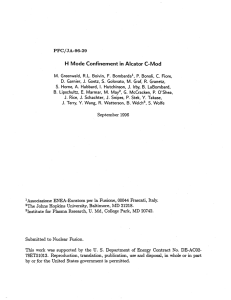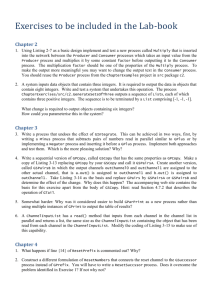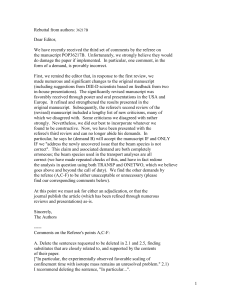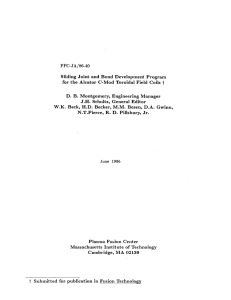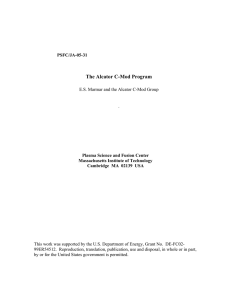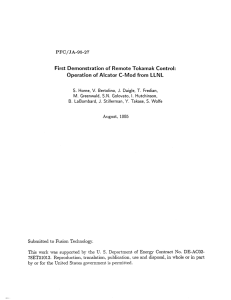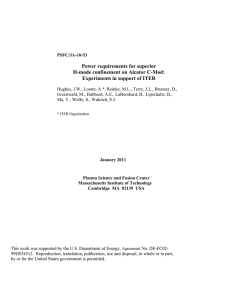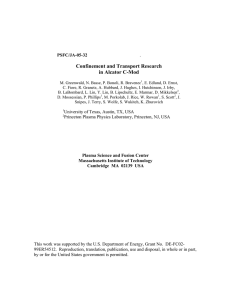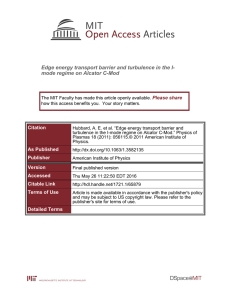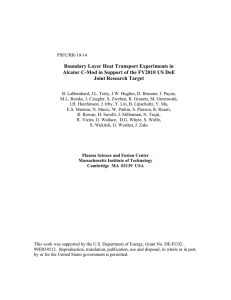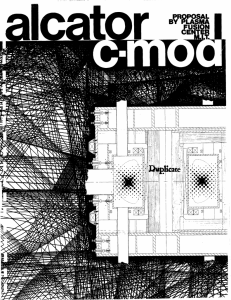Transport Phenomena in Alcator C-Mod H-Modes
advertisement
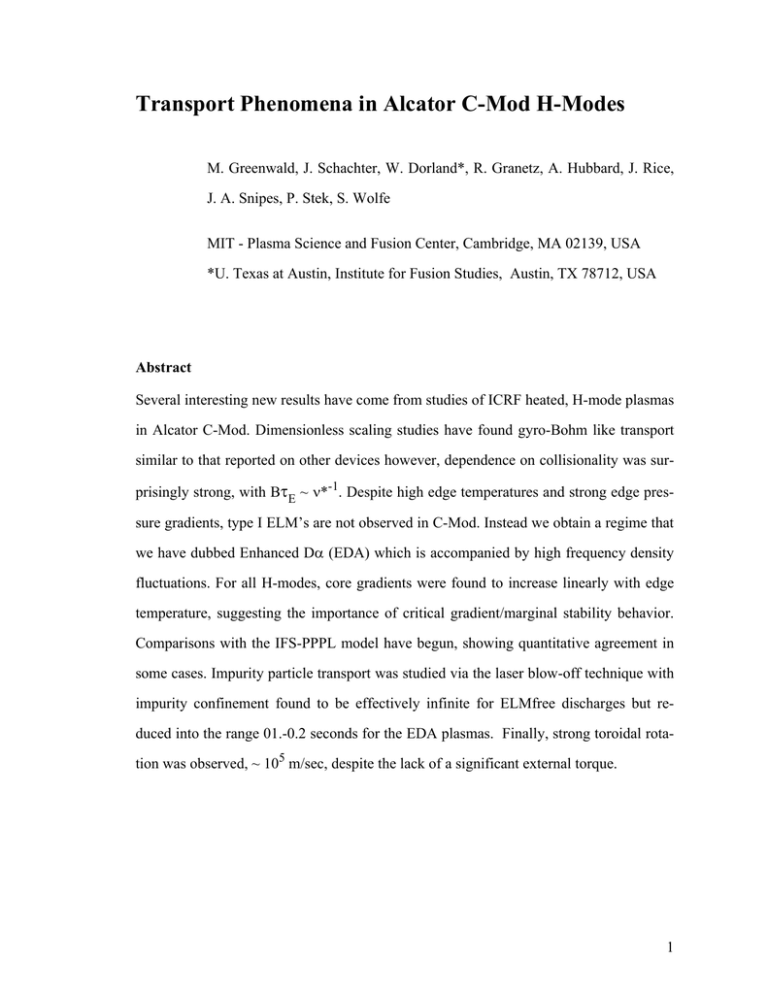
Transport Phenomena in Alcator C-Mod H-Modes M. Greenwald, J. Schachter, W. Dorland*, R. Granetz, A. Hubbard, J. Rice, J. A. Snipes, P. Stek, S. Wolfe MIT - Plasma Science and Fusion Center, Cambridge, MA 02139, USA *U. Texas at Austin, Institute for Fusion Studies, Austin, TX 78712, USA Abstract Several interesting new results have come from studies of ICRF heated, H-mode plasmas in Alcator C-Mod. Dimensionless scaling studies have found gyro-Bohm like transport similar to that reported on other devices however, dependence on collisionality was surprisingly strong, with BτE ~ ν*-1. Despite high edge temperatures and strong edge pressure gradients, type I ELM’s are not observed in C-Mod. Instead we obtain a regime that we have dubbed Enhanced Dα (EDA) which is accompanied by high frequency density fluctuations. For all H-modes, core gradients were found to increase linearly with edge temperature, suggesting the importance of critical gradient/marginal stability behavior. Comparisons with the IFS-PPPL model have begun, showing quantitative agreement in some cases. Impurity particle transport was studied via the laser blow-off technique with impurity confinement found to be effectively infinite for ELMfree discharges but reduced into the range 01.-0.2 seconds for the EDA plasmas. Finally, strong toroidal rotation was observed, ~ 105 m/sec, despite the lack of a significant external torque. 1 1. Introduction Previous work [1,2] reported on heating and confinement experiments on C-Mod Hmodes. The C-Mod device is somewhat unique in several respects. First, as a compact high-field device, it typically runs at high densities where Ti~Te and where fast-ion content is minimal. Secondly, its only auxiliary heating scheme is ICRH, while most machines report results with NBI. Finally, all plasma facing components are made of the refractory metal molybdenum overcoated with boron. Energy confinement in H-mode is typically about 2 times that of L-mode and somewhat greater than that predicted by scaling laws derived using data from other devices [1]. Experiments described here were carried out with BT from 2.6 - 8 T, IP from 0.4 - 1.2 MA, ne from 2 - 4 x 1020/m3, κ from 1.5 - 1.8, and input power from 1.7 to 3.5 MW. 2. Dimensionless Scaling The difficulties encountered with traditional empirical scaling methods have encouraged several groups to begin systematic investigations into the dimensionless scaling of plasma transport [3,4]. This approach offers the possibility of straightforward extrapolation to reactor regimes and at least a tenuous connection with the underlying physics [5]. On C-Mod, experiments were carried out to determine the scaling of the normalized confinement time, BτE, and normalized thermal diffusivity, χ/χBohm, with ρ* and ν* [6]. With a fixed ICRH frequency of 80 MHz, these experiments compared deuterium discharges heated via first harmonic hydrogen minority at 5.3 T to those heated at second harmonic hydrogen minority at 2.6 T. In the first set of experiments, heating power, plasma current and density were adjusted to match the profiles for q, β, and ν* while varying ρ* by a factor of about 1.6. Further experiments matched β and ρ* while varying ν* by almost an order of magnitude The results of the ρ* scans can be seen in figure 1. Global scaling was observed to be 2 gyroBohm like; that is, BτE was found to be proportional to ρ*-3.1 where Bohm scaling would imply BτE ~ ρ*-2. The error in the ρ* coefficient was estimated conservatively to be +/- 0.6. Figure 1b shows the results of local analysis of a pair of shots from the same data set. In this case, the ratio of normalized thermal diffusivity between a high field discharge and a low field discharge are plotted. Again, the results are consistent with gyroBohm scaling across most of the profile. Errors in this measurement are large and separation of the ion and electron channels is probably not statistically significant. These results are similar to those reported in references 3 and 4. Surprisingly, even with all three experiments, C-Mod, DIII-D, and JET, showing gyro-Bohm scaling; scaling between these machines gives a result closer to Bohm [1]. The results of the collisionality scans, shown in figure 2, showed a surprisingly strong dependence. Both global and local analysis gave approximately a linear dependence on ν*. 1.5 2.5 T 5.3 T (χeff/χB)HI / (χeff/χB)LO BτE (T s) 1.00 0.10 -3.1 ± 0.6 BτE ~ ρ∗ 0.01 5 6 7 8 ρ∗ x 1000 9 10 1.0 Goldston Bohm gyroBohm 0.5 0.0 0.2 0.3 0.4 0.5 0.6 0.7 Normalized Radius 0.8 Figure 1. Results of normalized gyro-radius, ρ* scans with q95, β (normalized plasma pressure) and ν* (normalized collisionality) fixed (a) Global scaling, showing the normalized energy confinement btau vs gyro-radius, ρ*, (b) Local scaling showing the ratios of normalized diffusivity, χ/χBohm between high field (low ρ*) and low field (high ρ*) plasmas. Expectations of different types of scaling are shown by the dotted curves [5]. Both local and global analysis show approximately gyro-Bohm like scaling. 3 1.5 2.5 T 5.1 T γ for χeff γ for χe γ for χi 1.0 γ (r) BτE (T s) 1.00 0.10 0.5 -1.0 ± 0.2 BτE ~ ν∗e 0.01 0.1 ν∗e 1.0 0.0 0.2 0.3 0.4 0.5 0.6 0.7 Normalized Radius 0.8 Figure 2. Results of ν* scans with q95, β, and ρ* fixed (a) Global scaling, showing btau vs ν* (b) Local scaling, showing the local exponent, γ, defined by χ ~ χBohmν*γ. Ap- proximately linear dependence is seen in both cases. 3. ELM’s/EDA We have observed a promising regime which evolves out of ELMfree discharges and is characterized by high levels of Dα light, good energy confinement and moderate particle confinement. [1,2] Because of uncertainty over the relationship of this mode to ELM behavior, we use the term Enhanced Dα (EDA) to describe it. Edge temperature pedestals typically are slightly smaller than in ELMfree discharges resulting in slightly reduced energy confinement. No type I ELMs have been observed so far on C-Mod though the edge temperature can be high, 600-800 eV, and the pressure gradient in the transport barrier would seem to challenge stability limits. Values of the edge β can reach 0.5% and recent data suggest that the pressure gradient length can be as short as 3-4 mm. The EDA is characterized by increased density fluctuations in the barrier region [7,8]. These are broadband, extending to at least 400 kHz with a quasi-coherent feature which can appear anywhere from 60 - 130 kHz. 4 4. Critical Gradient/Marginal Stability Behavior Edge temperature and core confinement are tightly correlated[1] for L and H-modes in C-Mod over a wide variety of regimes including ELMfree, and ELMy/EDA H-modes, ordinary L-modes, and "enhanced" L-modes which are achieved by strong heating of reversed field plasmas. This result is summarized in figure 3 where the core electron temperature gradient is plotted against the pedestal temperature, demonstrating that the improved confinement is not merely the result of adding a temperature and density pedestal to an L-mode discharge. Here, the core gradient is defined as an average over the region outside the sawteeth and inside the edge transport barrier. This behavior is qualitatively consistent with critical gradient transport models (for example, ITG turbulence). Figure 3. The average core Te gradient is plotted vs edge temperature (measured at the 95% flux surface). The core gradient is defined as the average gradient between the outer edge of the sawtoothing region and the top of the H-mode pedestal. 5 Figure 4 shows the result of a simulation from one such theory, the IFS-PPPL model [9] plotted against experimental data. The model gives fairly good agreement for ion temperatures in C-Mod H-modes (though it consistently underpredicts Ti in L-mode) [6]. The electron temperature is often overpredicted as shown in the figure. There are a number of possible reasons for this. First, Dorland’s nt code, which is used for the simulations, does not have a sawtooth model and sawteeth are very strong in C-Mod discharges. The result of adding an ad-hoc sawtooth mixing model to the simulation substantially reduces the discrepancy as shown in the figure. Second, the model only includes effects on the electrons from the ITG mode and additional sources for electron may be present. Finally, it is worth noting that the C-Mod collisionality falls outside the range of validity assumed in reference 9. 8 Te measured Ti measured Ti, No sawteeth Ti With sawteeth Te No sawteeth Te With sawteeth keV 6 4 2 0 0.00 0.05 0.10 r (m) 0.15 0.20 Figure 4. Comparison between experimental data and predictions of the IFS/PPPL model. Predictions both with and without an ad-hoc sawtooth model are shown. Agreement is fairly good for H-modes in C-Mod. 6 5. Impurity transport Impurity particle confinement, τI, in ELMy/EDA plasmas is in the range 0.15-0.2 seconds, roughly 2-3 x τE, unlike ELMfree plasmas where τI > 0.5 seconds. Analysis of impurity profile evolution following injection of trace amounts of scandium by the laser blow-off technique can yield estimates of the transport coefficients. Compared to Lmode plasmas, in H-mode these are characterized by lower diffusivity in the core, and a transport barrier with very low diffusivity and a strong inward pinch in the plasma edge. Barrier diffusivity is higher and the pinch weaker for ELMy/EDA discharges than for ELMfree. This difference may be the result of additional turbulence which is observed as density fluctuations seen during EDA as described above. 6. Plasma Rotation Another interesting new result on C-Mod is the observation of strong central toroidal rotation in H-mode discharges with only ICRF heating [10]. For the majority ions, velocities up to 1.5 x 105 m/sec and Mach numbers on the order of 0.3 were measured and were correlated with good core confinement and high stored energy rather than with high input power alone, rotation being much stronger in H-mode than in L-mode or ohmic plasmas. While full rotation profiles are not yet available, strong shear is seen in the central rotation and Er’ may be large enough to affect transport. Though the origin of rotation of this magnitude in the absence of appreciable external torques is unclear, early speculation has centered on turbulent Reynold’s stress. Acknowledgements The authors wish to thank the rest of the Alcator team, the technical staff, engineers, students, and scientists. This work was supported by DOE contract No. DE-AC0278ET51013. 7 References [1] M. Greenwald, et al., 1997, Nucl. Fus., 37, 793. [2] Y. Takase, et al., 1997, (Proceedings of 16th Int. Conf., Montreal 1996), Vol 1, IAEA, Vienna (1997) 475. [3] C.C. Petty, et al., 1995, Phys. Rev. Lett., 74, 1763. [4] J. G Cordey, and JET team, 1997, Fusion Energy 1996 (Proc. 16th Int. Conf. Montreal, 1996), Vol. 1, IAEA, Vienna (1997) 603 [5] R.E. Waltz, J.C. DeBoo, M.N. Rosenbluth, 1990, Phys. Rev Lett., 65, 2390. [6] J. Schachter, 1997, "Local Transport Analysis for the Alcator C-Mod Tokamak", PhD thesis, PSFC/RR-97-12. [7] P. Stek, 1997, "Reflectometry Measurements on Alcator C-Mod" PhD thesis, PSFC/RR-97-5. [8] J. Snipes, et al., 1997, "ELMs and Fast Edge Fluctutaions in Alcator C-Mod", this conference [9] M. Kotschenreuther, W. Dorland, M. A. Beer, and G.W. Hammett, 1995, Phys. Plasmas, 2, 2381. [10] J. Rice, et al, 1997, "Observation of Central Toroidal Rotation in ICRF Heated Alcator C-Mod Plasmas", to be published in Nuclear Fusion. 8 Figure Captions Figure 1. Results of normalized gyro-radius, ρ* scans with q95, β (normalized plasma pressure) and ν* (normalized collisionality) fixed (a) Global scaling, showing the normalized energy confinement btau vs gyro-radius, ρ*, (b) Local scaling showing the ratios of normalized diffusivity, χ/χBohm between high field (low ρ*) and low field (high ρ*) plasmas. Expectations of different types of scaling are shown by the dotted curves [5]. Both local and global analysis show approximately gyro-Bohm like scaling. Figure 2. Results of ν* scans with q95, β, and ρ* fixed (a) Global scaling, showing btau vs ν* (b) Local scaling, showing the local exponent, γ, defined by χ ~ χBohmν*γ. Approximately linear dependence is seen in both cases. Figure 3. The average core Te gradient is plotted vs edge temperature (measured at the 95% flux surface). The core gradient is defined as the average gradient between the outer edge of the sawtoothing region and the top of the H-mode pedestal. Figure 4. Comparison between experimental data and predictions of the IFS/PPPL model. Predictions both with and without an ad-hoc sawtooth model are shown. Agreement is fairly good for H-modes in C-Mod. 9





